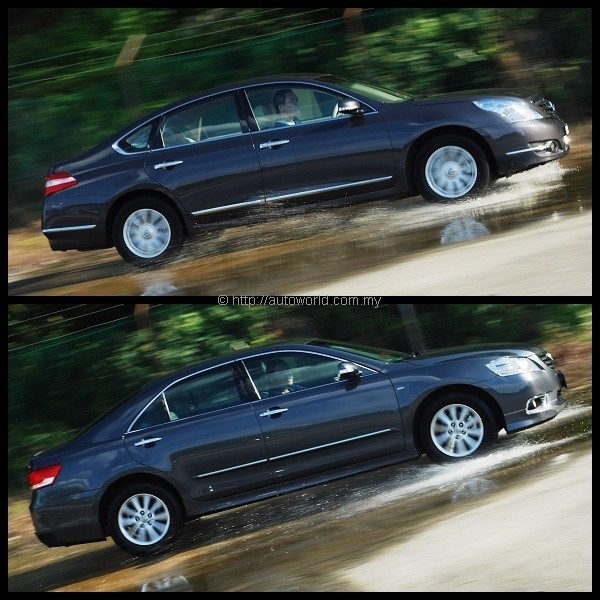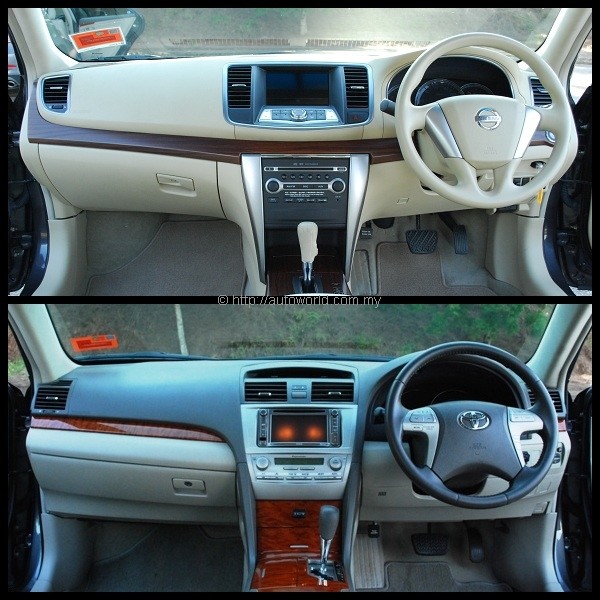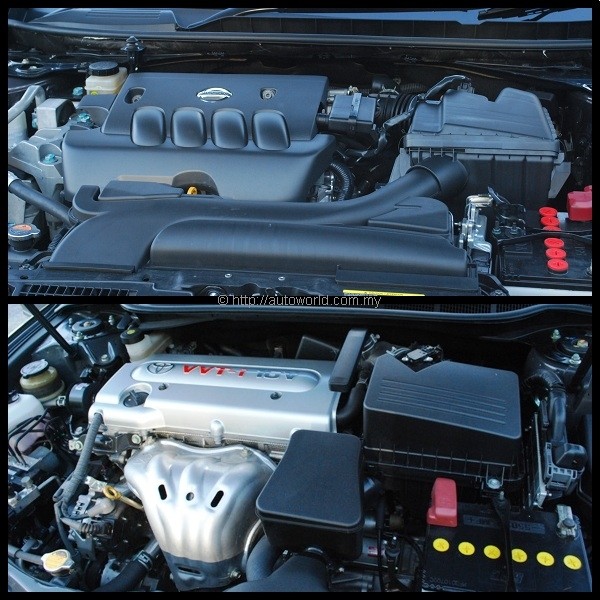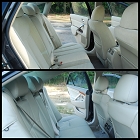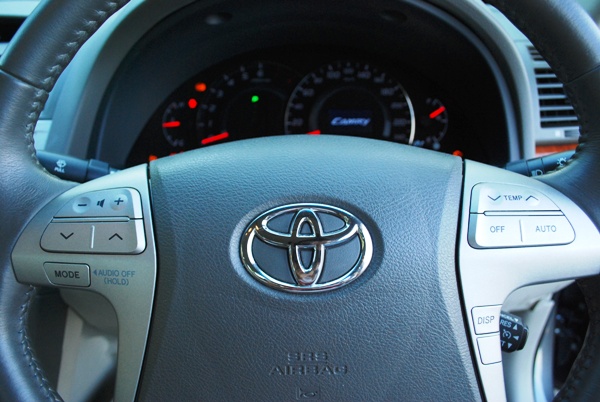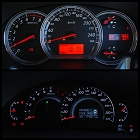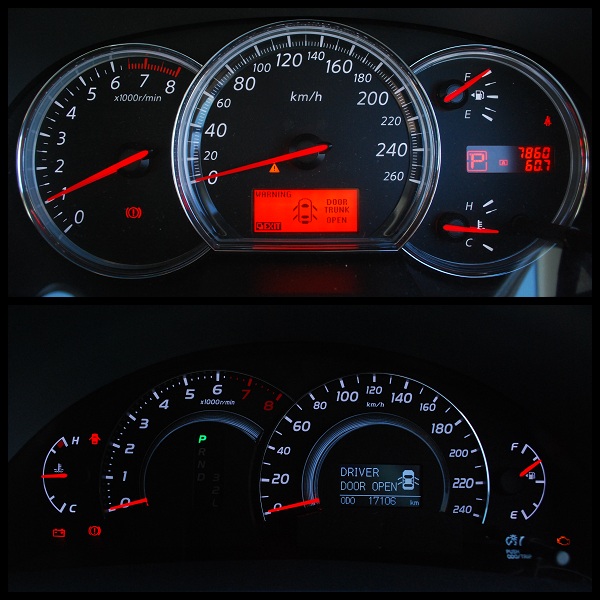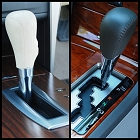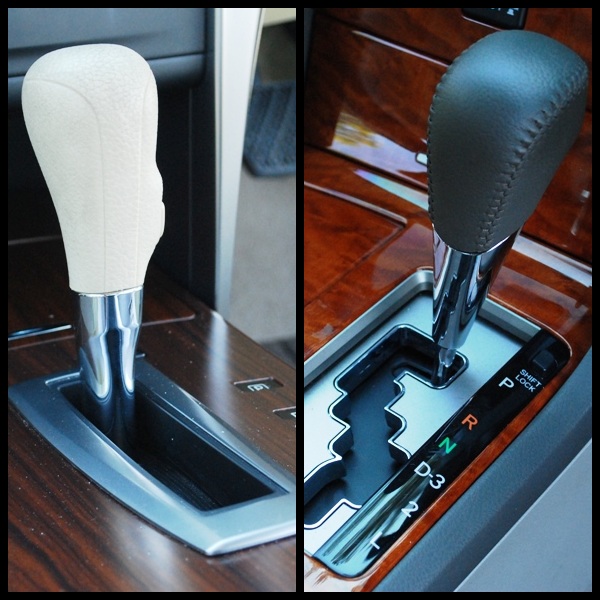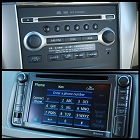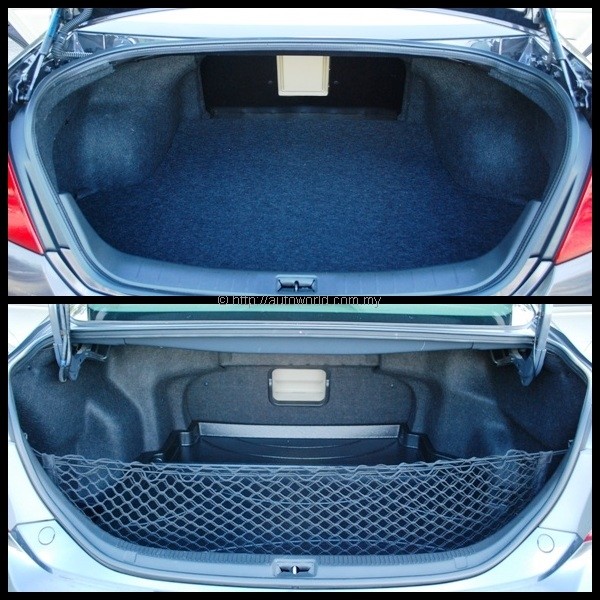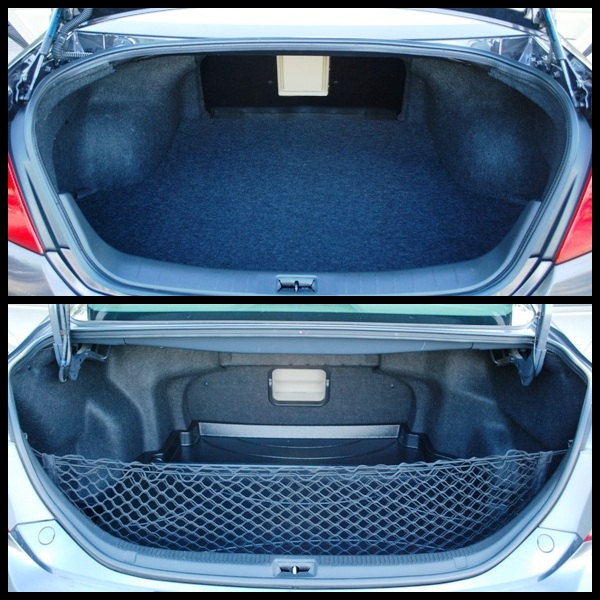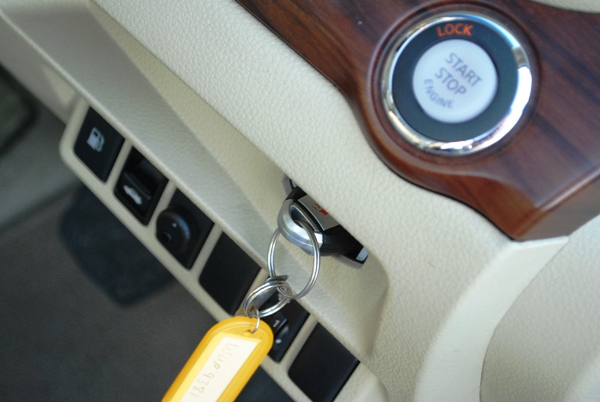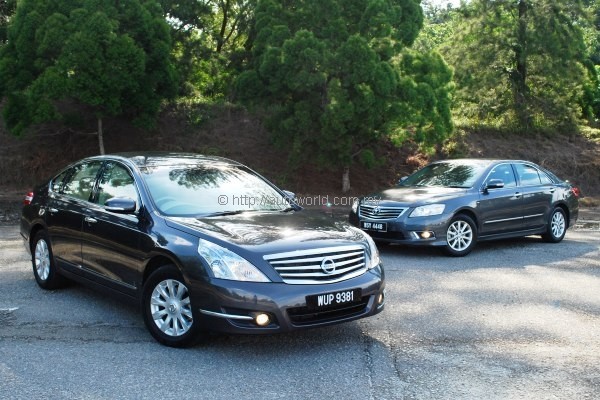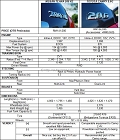Nissan’s launch of the Teana last year marked its long-awaited return to the D-segment that has been dominated by the Honda Accord and Toyota Camry in recent times. When they sent us a unit of the Teana 2.5 for review, we were mightily impressed. Spacious, powerful, well-equipped and not even boring to drive, the Teana 2.5 has all the ingredients to be a segment-winner.
That’s the 2.5, but what about the 2.0-litre model sitting lower down the range? With reduced power and equipment, can we still hold the 2.0-litre Teana in the same high regard as its bigger brother? What better way to find out than a direct comparison with the market’s biggest player – the Toyota Camry.
| Image may be NSFW. Clik here to view.  |
| Camry does not yet look out-of-date when parked next to the Teana’s fresh shape. |
The Test Cars
In this encounter, Nissan is represented by the entry level Teana 200 XE Comfort spec. There is a slightly more expensive 200 XE Luxury variant, but that adds only leather seats and front cornering sensors into the equipment list for a premium of RM4,000. At the basic equipment level of our test car, the price tag reads RM141,000 with insurance.
Meanwhile, Toyota sent us the Camry 2.0G that comes bristling with kit and equipment. Its on-the-road price with insurance is RM154,990, but our test car comes further loaded with an Aerokit package (RM2,650), Toyota premium solar film (RM2,400) and a DVD-AVN Package which includes sat-nav and reverse camera (RM4,500). All these goodies serve to push the final price of our Camry test car to a cool RM24k higher than the Teana’s.
Some of you might recognize our Camry test car – it was the same unit used in a shootout against the Honda Accord 2.0 VTi-L over a year ago. At that time, the car had clocked only 1,700km on the road. Its mileage has since went up to 17,000km, and it has also been retrofitted the previously unavailable DVD unit – which explains why the dash would look slightly different this time to the eagle-eyed readers.
Admittedly, the more affordable Camry 2.0E at RM144,990 would probably serve as a better match against the Teana, but we opted for the 2.0G on the grounds that it is the model’s best selling variant, making up nearly three-quarter of total Camry sales in 2010. On the contrary, Teana sales are tilted in favour of its 2.5 variant, which accounts for 60% of the big Nissan’s total sales.
| Image may be NSFW. Clik here to view.  |
Specs Sheet
Both cars derive power from 2.0-litre four-pot aluminium engines with 16 valves, twin camshafts and variable valve timing. Overall displacements differ by just one cubic centimetre, but there’s a bigger gap where horsepower is concerned, and here, the Camry takes an early lead with a 9hp advantage over the Teana.
The Teana’s 1,997cc MR20DE engine serves up 134 horses at 5,600rpm, but at 400 revs later the Camry’s 1,998cc 1AZ-FE shows its bigger hand of 145hp. Both cars develop the same maximum torque of 190Nm, with the Camry peaking earlier at 4,000rpm compared to the Teana’s 4,400.
The transmission department is where the Camry is showing its considerable age; its a 4-speed automatic transmission competing in a market where five or six ratios are being the norm. In the Teana’s case, there is an infinite number of possible ratios from its Jatco-sourced X-Tronic CVT. Unlike some rival CVTs, Nissan has opted not to provide the Teana with virtual ratios for manual overriding.
| Image may be NSFW. Clik here to view.  |
| Teana’s X-Tronic CVT completely trumps Camry’s 4 A/T in smoothness and refinement. |
Basic ingredients of the chassis are comparable – both feature all-round disc brakes, independent suspension and hydraulic assisted rack & pinion steering. Safety gears are evenly matched as well – dual frontal airbags, ABS, EBD, Brake Assist, seat belt pre-tensioners, and immobilizer being standard equipment. Neither gets stability or traction control, which are only offered in their bigger brothers.
In terms of size, the Teana is 25mm longer than the Camry, but it is neither as wide nor as tall; both have the same 2,775mm wheelbase. A crucial difference is in kerb weight – whereas the Teana tips the scales at 1,455kg kerb weight, the Camry has an additional 55kg of mass to lug around at 1,510kg.
Interior
Stepping inside, both the Camry and Teana welcome you into spacious cabins with excellent ambiance. Beige interiors stain easily, but they also convey a sense of airiness and spaciousness which makes the Teana’s cabin feel even more pleasant to sit in.
The Teana’s interior will particularly appeal to those who appreciate the concept of minimalism, but unfortunately it is also minimal in equipment. Having praised Nissan for giving us a well-appointed Teana 2.5, the 2.0 here brings us back to the same criticisms leveled against its other models. A steering wheel without buttons was difficult enough to swallow in the Sylphy, let alone a full-fledged D-segment offering like the Teana.
On the kit count front, the Camry quickly got to work to justify it’s 24 grand premium over the Teana. The Nissan starts strongly with a push-start button and auto headlights, but everything else it has – headlamp level control, electric folding side-mirrors with built-in signal lamps, variable intermittent wipers, 6-CD changer, multi-info display, dual-zone auto climate control with rear blowers, and anti-pinch driver power window – is matched or bettered by the Camry.
| Image may be NSFW. Clik here to view. 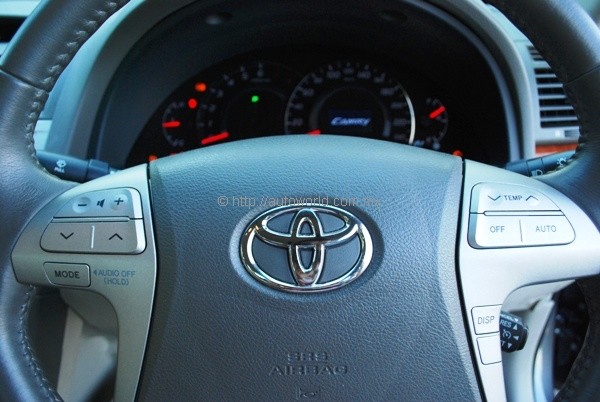 |
| Camry’s steering has buttons as you would expect, but not the Teana’s. |
The Camry 2.0E more or less matches the Teana 200 XE’s bells and whistles, but our 2.0G test car here adds leather trim, HIDs with auto-leveling, electric front seats, tilt & telescopic steering adjustment, steering-mounted controls (not just for audio, but for air-con as well), auto cruise, and that is before we bring in the optional DVD-AVN unit installed in our test car.
| Image may be NSFW. Clik here to view. 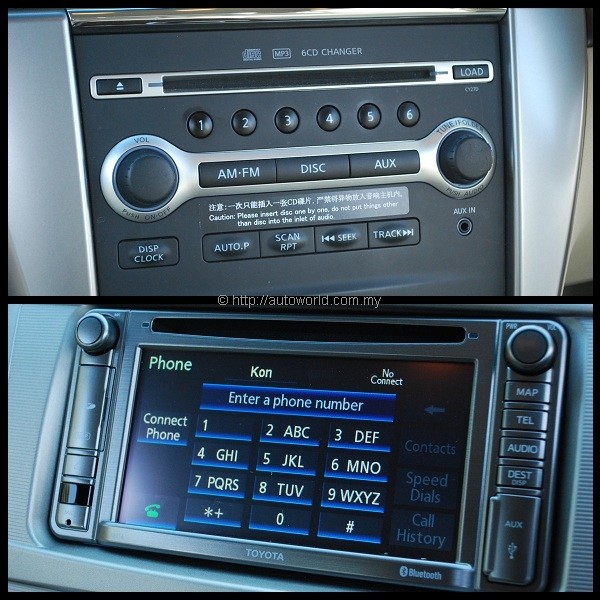 |
| Teana’s cabin is a study of minimalism, but Camry’s optional LCD touchscreen gives extra wow factor |
On the Move
When we tested it earlier this year, the Teana 2.5 served us a massive surprise. Not only was it refined and comfortable as Nissan touted, it also added a healthy dose of driving fun into the equation. Nissan pretty much nailed that much sought after balance between ride and handling spot on with the Teana.
Down to the 2.0, that growling V6 rumble is lost, but the overall driving experience remains pleasant. We have tried the MR20DE engine and X-CVT partnership in both the Sylphy and X-Trail, but here in the Teana is where the combo feels at its best. It has a more pleasant aural quality about it, and the engine seemed to have less qualms approaching its redline than in the other two models.
As a result, even if it has to work harder than the 2.5 V6, the engine never felt like it was not up to mark in its task of hauling the Teana’s sizable frame around. The same cannot be said of the Camry, which is probably hampered by its extra weight and less-than-efficient 4-speeder slushbox.
Driven in isolation, the Camry is an adequate performer. A 4-speed auto might be regarded as a handicap in the market these days, but that is a drawback that can be mitigated with careful selection of ratios and intelligent programming of the transmission control system. The Camry never felt like it needed a fifth ratio, but its kick-down response time can be improved.
In a back-to-back drive, you would not have guessed that the Camry actually boasts a 9hp advantage over the Teana. On many occasions, it was the Nissan that felt livelier and more energetic when the need to summon acceleration arose. We can perhaps attribute this to the Teana CVT’s ability to constantly keep the engine spinning at the peak of its power band, whilst the Camry’s auto has to rigourously shift between its four ratios.
Ride and handling similarly feels better sorted with the Teana. While both cars have comparable comfort levels, the Teana feels way more receptive to hard driving. At corners, the Teana’s chassis possesses greater poise and feels more communicative compared to the Camry’s, and this is despite our Teana test car having a slightly mis-aligned steering. Overall NVH, an important point of assessment in this market, is better suppressed in the Teana.
| Image may be NSFW. Clik here to view.  |
| Teana has better resolved driving dynamics than the Camry |
Verdict
On the whole, the Teana felt generally better to drive compared to the Camry. It loses little to the Camry in terms of comfort, but is significantly better in terms of handling and overall driveability. The silky smooth MR20DE/X-CVT combo also feels miles ahead of the Camry’s antiquated 4-speed drivetrain.
A telling comparison between these two models is how they stack up against their bigger brothers. For the Camry, we have no qualms recommending you the 2.0G over the 2.4V, considering the similar equipment levels between both variants. The same recommendation is difficult to make for the Teana 2.0, which feels like a purchase made because you cannot afford the 2.5.
While the Teana proved to be the better car to drive, the Camry makes it easier to justify opting for its smaller-engine variant. Although Malaysian customers generally prefer smaller engines, they want their cars fully equipped, and it is here that the Camry addresses this need with the 2.0G.
As far as the 2.0-litre variants tested here are concerned, it is honours even at the final whistle, but Nissan should definitely see this as two points dropped. A higher-specced Teana 2.0 would have walked away with this contest.
| Image may be NSFW. Clik here to view.  |
The post Nissan Teana 200 XE vs Toyota Camry 2.0G – The 2.0-litre D-segment battle appeared first on Autoworld.com.my.
